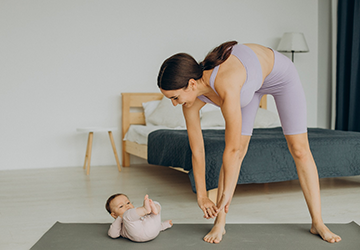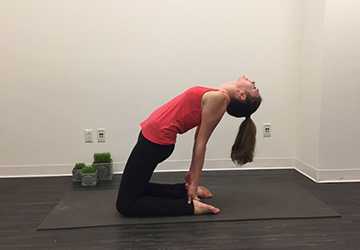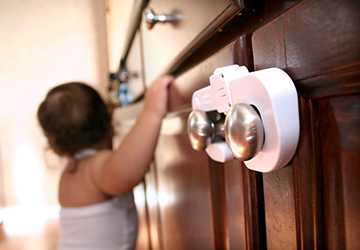Top 12 Postpartum Exercises for New Mothers
Hopefully, this little one of yours will bring you joy, happiness, and warmth. As you begin this great adventure of motherhood, it is of great significance to regard your postpartum recovery as the primary objective. While cuddling and bonding time with your baby are sweet, including a few light physical activities in your routine can do wonders for your physical and mental state.

Whether you are a first-time mom or about to have your second or even third baby, these postnatal exercises are designed for new mothers like you and will help you regain your strength, boost your energy levels, and promote health in general. Thus, here are the star postpartum exercises that will accompany you and be the key to your postpartum wellness.
1. Pelvic Tilts
For the first time in your life as a new mom, your pelvic floor muscles have been subjected to a lot of implementation during the pregnancy and childbirth process. The pelvic tilts are like a friendly alarm clock that wakes these muscles—lying on your back with both knees bent and feet flat on the floor. Now, keeping the lower back in the normal position, slowly tilt the pelvis up, and as you do so, try to contract the core muscles. Think of it as putting a little pressure on the area between the back of your pelvis and the ceiling. Pause for a few seconds, and then breathe out. Do this movement for 10-15 reps. You wouldn't think that such small movements can bring you so much benefit, but they can.
2. Kegels
Let's discuss Kegels – the unnoticed yet most essential exercises for postpartum recovery. Picture this: you're cutting off the urine when it's halfway through the flow! It's the just motion you need to reproduce. Squeeze and hold the pelvic floor muscles for 5-10 seconds, then relax. It's simple but oh-so-effective. Work for that many repetitions, 10-15 times a day. Work them into your routine as you change your baby's diapers or during those magical moments of breastfeeding and rocking your child to sleep. These little exercises help recover your pelvic floor's strength and control and can also make a more significant impact on your health.
3. Brisk Walking
It is time to turn your shoes on and run for that mile! The brisk walking technique is an excellent way to start gently exercising postpartum. Begin with brief and leisurely walks around the nearby area, pushing the pram if you prefer, then increase your speed once you start feeling more comfortable. Walking is low-impact, gentle on your knees and ankles, and suitable for circulating blood and boosting mood. Also, it is used to catch a breath of fresh air and is a source of vitamin D that one needs.
4. Modified Push-Ups
Let's include pull-ups in our upper body workout by performing the modified push-ups. Don't panic; we're not heading you to those military-style push-ups yet. First, stand tall, keeping your back in one line and the core tense. Lift your body by bending down. Then, push it back up. Complete 5-10 reps initially, but pause when needed. With time, you can gradually multiply the number of the reps you do. That way, you'll ton your biceps, pectorals, and shoulders while recovering.
5. Seated Leg Lifts
If you are preparing to focus on those muscles in the lower part of the body, seated leg lifts are a good way. Sit on a chair, slightly leaning forward, with your feet flat on the floor. Slightly bend one knee, lift the leg out in front, then lower it back with control. Mirror it on the other side. Listening to music and singing along has been a delightful activity. It has brought me so much joy and comfort throughout my life. Try to do 10-15 reps on the right and left side. Just this exercise regularly will help you tone your quads, hamstrings, and glutes – one of the best ways to combat the weaknesses of pregnancy and childbirth.
6. Planks
Finally, but by no means the least, you can start with planks, an excellent exercise for core muscles. This exercise begins in a push-up position and continues with lowering the body onto the forearms. Imagine your body as a rod from the head to the heel, and your core muscles will be engaged throughout the exercise. Teach for 20-30 seconds; then release. Let's say that you are not ready for a full plank today; try starting from your knees and work your way up. Planks are great tools for your core and posture and fighting backaches that are common after motherhood. Moreover, they are very productive — a few seconds can bring you close to success.
7. Pelvic Floor Bridges
Lying on your back with knees bent and feet flat on the floor, place your hands behind your head and keep your elbows close to your head. Alongside the glute muscles, these exercises activate pelvic floor muscles that aid postnatal recovery. As you lift your hips and lower back down, push your hips towards the ceiling and contract your glutes and pelvic floor muscles.
Hold the lifted posture for a few seconds, be it a second or two, ensuring the muscles are still under tension, then lower down with control. Aim for 10-15 repetitions to improve these critical areas of the body. This exercise can effectively prevent pelvic floor dysfunction and improve overall core stability.
8. Yoga
In the early days after childbirth, postpartum yoga is a gentle yet effective way to improve flexibility, strength, and relaxation. Avoid classes or videos for the general public since these will likely contain poses and modifications unsuitable to your postpartum body. Yoga includes gentle and stretching poses and mindful breathing exercises, which help with tension relief, improved posture, and mental well-being, which are crucial during this transformation time.

9. Cycling
If you have an exercise bike, cycling is an easy cardiovascular workout for post-birth fitness. Start with a low resistance level to keep the muscles free of strain, then increase it as your strength and endurance improve. Cycling involves essential muscle groups in an even manner, but it is an excellent choice for people with joint problems who should not be overworked because it helps rebuild stamina and boost mood.
10. Squats
Building the strength of the lower body is a must if you want to be physically active enough after childbirth, and squats are perfect for this goal. Place your feet at a hip-width distance, and simulate sitting back on a chair by bending your knees. Avoid the hunchback posture by lifting your chest, and watch out that your knees are always over your toes to preserve your joints. Try to do 10-15 repetitions, being conscious of keeping your form correct so that you do not injure yourself, and also, you make sure of effectiveness.
11. Dumbbell Rows
One can use dumbbell rows, a popular and efficient weight-training exercise for upper back and arm strength. Pick up a pair of dumbbells with both hands and stoop forward at the hips, keeping your back straight from your upper body to your hips. Then, pull your arms up to the level of your ribcage, squeezing your shoulder blades together at the top of the movement. Bring the weights down again with control and perform 10-15 reps. This exercise improves your posture and upper body strength, which is essential for any caregiving and carrying of your baby.
12. Stability Ball Exercises
During your postpartum workout, you could add a stability ball to achieve better balance, core stability, and overall strength. Attempt doing some exercises like stability ball crunches, bridges, and pelvic tilts, which can work out different body parts while simultaneously challenging your balance. Besides restoring a solid core, those routines also improve posture and back pain, the most critical issues for a new mother. Start with the more comfortable reps and add up after you feel you can.
Conclusion
Your experience as a new mother will surely bring numerous joys and challenges. Therefore, you should be gentle with yourself and listen to your body. The post-labour period in a woman's life is a period of great diversity and change, and taking things one step at a time is fine. By implementing these 12 abdominal exercises in your routine, you care for your physical health and its psychological effects.
In addition, consider the victories, regardless of small steps, and do not refrain from asking for help when needed. Gradually, giving birth will become a memory, and you will be proud to have gone through it. Ultimately, you will come out of the postpartum phase feeling stronger, healthier, and more empowered. Mommy, you can! I love you, and I'm so proud of you!





